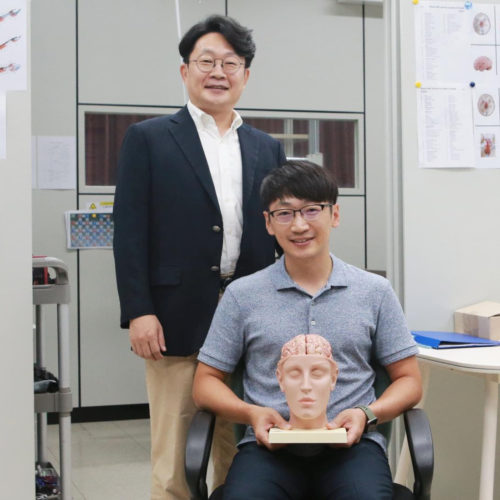by Centenary Institute Credit: CC0 Public Domain Research led by the Centenary Institute has discovered that the lack of an enzyme in the liver called sphingosine kinase 2 (SphK2) results in pronounced insulin resistance and glucose intolerance, both symptoms of early stage type 2 diabetes. The findings raises the possibility of a new treatment approach for diabetic...
Microbes in the gut may influence metabolism
by Katherine Fenz, Rockefeller University A cross section of the colon with enteric neurons highlighted. These neurons interface directly with gut microbes. Credit: Rockefeller University The 10 trillion bacteria living in your digestive system may not be human, but they seem to be as integral to your body as your heart or liver. A growing number...
DNA damage caused by migrating light energy
KARLSRUHER INSTITUT FÜR TECHNOLOGIE (KIT) IMAGE: DNA IS EXPOSED TO UV RADIATION FROM LEDS TO STUDY HOW FAR THE PHOTOENERGY MIGRATES. CREDIT: (PHOTO: ARTHUR KUHLMANN, KIT) Ultraviolet light endangers the integrity of human genetic information and may cause skin cancer. For the first time, researchers of Karlsruhe Institute of Technology (KIT) have demonstrated that DNA...
Drug for common liver condition may be an effective treatment for dementia
UNIVERSITY OF YORK A drug used to treat cirrhosis of the liver may be an effective treatment for a form of Dementia and motorneuron disease, scientists have discovered. The research, led by the University of York in collaboration with the University of Sheffield, used brain cells from fruit flies and rats to model the neurodegeneration...
You can train your brain to reduce motion sickness
UNIVERSITY OF WARWICK IMAGE: WMG’S 3XD SIMULATOR AT THE UNIVERSITY OF WARWICK. CREDIT: WMG, UNIVERSITY OF WARWICK Visuospatial training exercises can train the brain to reduce motion sickness, providing a potential remedy for future passengers riding in autonomous vehicles. Researchers at WMG, University of Warwick reduced motion sickness by over 50% using the training tool...
Touch-and-know: Brain activity during tactile stimuli reveals hand preferences in people
DGIST (DAEGU GYEONGBUK INSTITUTE OF SCIENCE AND TECHNOLOGY) IMAGE: PRINCIPAL SCIENTIST DR JINUNG AN (LEFT) AND MR SANG HYEON JIN (RIGHT) IN THE LABORATORY OF BRAIN-ROBOT AUGMENTED INTERACTION FOR NEUROPLASTICITY AT DGIST. CREDIT: DGIST Have you ever wondered whether the brains of right-handed people work differently from those of left-handers? Is it possible to distinguish...
Painless paper patch test for glucose levels uses microneedles
INSTITUTE OF INDUSTRIAL SCIENCE, THE UNIVERSITY OF TOKYO Tokyo, Japan — Patches seem to be all the rage these days. There are birth control patches, nicotine patches, and transdermal medicinal patches, just to name a few. Now, a team of researchers led by Beomjoon Kim at the Institute of Industrial Science, The University of Tokyo...
A bifidobacterial protein that can reduce inflammation in COVID-19 found by a RUDN geneticist
RUDN UNIVERSITY IMAGE: A GENETICIST FROM RUDN UNIVERSITY STUDIED THE EFFECT OF BIFIDOBACTERIUM (INTESTINAL BACTERIA) ON THE INFLAMMATORY PROCESS AND DISCOVERED THAT THEIR SURFACE PROTEIN IS CAPABLE OF STOPPING EXCESSIVE OR UNCONTROLLABLE INFLAMMATION. CREDIT: RUDN UNIVERISTY A geneticist from RUDN University studied the effect of Bifidobacterium (intestinal bacteria) on the inflammatory process and discovered that...
Imaging agent developed at Washington University spotlights inflammation
WASHINGTON UNIVERSITY SCHOOL OF MEDICINE Many of the most common diseases — cancer, diabetes, cardiovascular and lung disease, and even COVID-19 — have been linked to chronic or excessive inflammation. Blood tests can indicate that some part of a person’s body is inflamed, but doctors don’t have a good way to zero in on the...
New insight into how muscles and fat cells work together to make you more fit
UNIVERSITY OF COPENHAGEN THE FACULTY OF HEALTH AND MEDICAL SCIENCES Why does exercise training make you more fit? It’s well established that exercising enhances insulin sensitivity and improves our metabolism that, in turn, increases exercise performance. But the biological mechanisms underlying this adaptation are not fully understood. New research published in the journal PNAS suggests that part...






